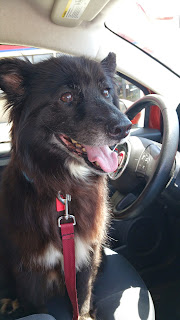 |
| Complications in the Carriage House by Stobridge Litho. Co., 1898 at Wikipedia Commons |
Wow, I can't believe its almost been a year since I last wrote something. Blog hibernation, anyone?
I try to always make these posts be something that I'm passionate about. If I'm not passionate about a topic, I figure its not worth writing about it because there's probably a million other people out there writing about it.
When I read Donna R. Causey's article "Have you ever been attacked by the Genealogy Police?" it was something that stuck with me. I have a great passion for welcoming people into genealogy, and she describes perfectly unfortunately what happens in genealogical disagreements.
In the exact same week, I read a letter from a friend in which she described doing the "Genealogy Do Over" and abandoning her existing research.
And at the same time, I've been working on fixing my Dutch ancestors on the FamilySearch Family Tree (shout-out to my fellow Teunis Nyssen and Phoebe Sales descendants) and realizing how much work is involved. I've spent two weeks and finally have them to a place where I can enter documents and such because all of the corrections have been made.
I think these events stuck with me because on February 19 (during the free time for Ancestry.co.uk), I discovered I had made a HUGE mistake. I had made 3 separate couples into one couple, therefore messing up completely the Toon family research that I had been working on since 2009.
My third great grandparents were James Toon (b. abt. 1829, Thringstone, Leicestershire, England), and Jane Halfpenny. James father was John Toon, b. abt. 1799 in Coleorton, Leicestershire, England.
John was married to an Elizabeth. That's all I knew for a long time, and when Amelia Elizabeth Wheatley and John Toon's marriage came together as hints in Ancestry, it all seemed to fit and check all the boxes - right age, close to the right area, and right name to fit with her census entries. So I went with it. So much so you can even see my own post naming her for certain.
I didn't think about this family very much - there is actually a Toon family expert so I know its been well covered - until that freebie weekend came up on Ancestry.co.uk. A hint was there for a marriage of John Toon and Elizabeth Preston all in Coleorton. As this would be the place John lived almost his entire life, it grabbed my curiousity, and I started looking through my evidence.
 |
| Actual photo from when I realized I made a mistake (j/k) Its a Domo! |
| 1851 census entry for Coleorton, Leicestershire, England for John Toon and Elizabeth Preston Toon with children Henry, Elizabeth, and Jane listed. |
The information I needed was actually right in their 1851 census entry. Elizabeth is listed as being born in Coleorton.
| Snapshot of the 1861 census for John Toon and Elizabeth Preston Toon showing their respective birthplaces. The 2 entries below are for grandchildren Mary J Toon and Thomas Toon. |
And its repeated in their 1861 census.
 |
| Some words may have been said that were harsher than this... Image courtesy of Tenor. |
So I not only had to fix the couple, I had to fix the family. And I had the wrong 1841 census, with the listing for Job Toon and Elizabeth, not John Toon and Elizabeth.
I promptly posted my angst on my Facebook feed, because I figured there were others who could commiserate with me. I mean, I'm sure other people make mistakes too, right?
 |
| This is the cutest cricket I have ever seen! Image from Animate It! |
I got one comment and a few status reactions. But I got a very interesting group of private messages, which I will summarize with two sentences:
- Aren't you afraid to admit you're wrong?
- Shouldn't you just start over?
This says to me that people are afraid to admit they made a mistake because they are afraid of what others will say. And with the fashionability right now of the "Do Over", people are willing to abandon their research rather than try to fix it.
What they lose by this is quite frankly, the ability to learn from their mistake. And when they abandon their research, its never truly off the Internet if they have posted online, had an online family tree, posted on message boards and mailing lists, etc. People will still find the research, even when its wrong. If you look at WorldConnect family trees for example, many people have different versions of the same tree on there.
7 days later, John Toon and Elizabeth Preston Toon are fixed. And their children are correct. I learned a lot about reading through and questioning evidence. And quite frankly, I would welcome people questioning my genealogy. It only gets better by people asking the question, reaching out, and chatting about theories, hypotheses, and conclusions.
Even as I read this, I find another write up on John Toon and Elizabeth Preston that suggests there might be more research needed on this family!
The 2017 Phillipps Research: John Toon and Elizabeth Preston Toon Family
John Toon, son of James Toon and Ann Possnett
b. abt. 1799 Coleorton, Leicestershire, England
m. 28 May 1822 Coleorton, Leicestershire, England
1841 census - Coleorton, Leicestershire, England
1851 census - Coleorton, Leicestershire, England
1861 census - Coleorton, Leicestershire, England
1871 census - Swannington, Leicestershire, England ***I ran out of time to confirm this one!
d. 1876
Elizabeth Preston
b. 1803 Coleorton, Leicestershire, England
m. 28 May 1822 Coleorton, Leicestershire, England
1841 census - Coleorton, Leicestershire, England
1851 census - Coleorton, Leicestershire, England
1861 census - Coleorton, Leicestershire, England
Children:
William Toon, b. abt. 1826
James Toon, b. abt. 1829
Henry Toon, b. abt. 1832
Alpheus Toon, b. abt. 1834
Mary Toon, b. abt. 1836
Elizabeth Toon, b. abt. 1839 (Q3)
Jane Toon, b. abt. 1840 (Q4)













